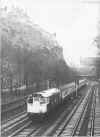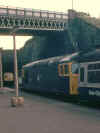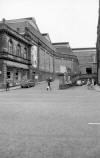In early 1972, following numerous problems with the class 27A locos when running the intensive services, the DM & EE received a request to carry out monitoring of the eleven-year old locomotives, which were now covering 650 miles each day. Among the defects were traction motor flashovers, bogie suspension components coming loose and the main generators causing concern as well as body stressing problems.
To achieve this Test Car 4 (the former Western Region Dynamometer car converted from a Hawksworth 3rd corridor coach) was especially modified with through-wiring for the 27-way control system and was brought up to Edinburgh. It was marshalled into a standard push-pull rake and we ran as a test train for a couple of days on 11th and 12th January 1972. I remember that the boss chose to stay in Edinburgh in preference to Glasgow as that city had a fearsome reputation at the time.
|
Test car 4 pictured in the EDU at Derby in 1982. The through control wiring can be seen on the RHS going over the roof. Colin Marsden |
Test Car 4 and its train were based at the former Leith Central station during the tests which was a mile or so from Waverley. It was a DMU depot for the class 126 Swindon InterCity units but must have been very close to closing when we were there. We stayed in a nice hotel on Princes Street and probably would have walked up and down Leith Walk to get to the train each day - no cars for the testing lads back then!
One of the locomotives would have been instrumented to measure bogie and body accelerations thus the effect of input from the track at the higher speeds could readily be assessed. I well remember there being a bad piece of track in Falkirk Tunnel which used to give the loco (and Test Car) a kick every time we passed.
I can't remember whether any modifications resulted from the tests but the service ran with class 27's for a further eight years but by 1980 the class 27 services had been superseded by class 47's, Mk3 coaches and DBSO MK2 driving van trailers.
There is an informative site by Nick Lawford here which gives more background to the original Push-Pull operation.












